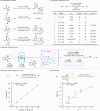Chiral sulfide and achiral sulfonic acid cocatalyzed enantioselective electrophilic tandem selenylation semipinacol rearrangement of allenols
- PMID: 40032867
- PMCID: PMC11876436
- DOI: 10.1038/s41467-025-57381-w
Chiral sulfide and achiral sulfonic acid cocatalyzed enantioselective electrophilic tandem selenylation semipinacol rearrangement of allenols
Abstract
A highly enantioselective electrophilic selenylation/semipinacol rearrangement of allenols has been developed, which is enabled by the cooperative catalysis of a chiral sulfide and an achiral sulfonic acid. The designed and synthesized chiral sulfide catalyst and selenylating reagent play a crucial role in enhancing both enantioselectivity and reactivity. This approach exhibits excellent regio-, chemo-, and enantioselectivity, providing access to diverse enantioenriched cyclopentanones featuring an arylselenovinyl-substituted quaternary carbon stereocenter. Furthermore, these products can be transformed into synthetically valuable alkyne, vinyl bromide, and aniline derivatives. Mechanistic studies reveal that the combination of a chiral sulfide and an achiral sulfonic acid not only facilitates the formation of catalytically active species, but also governs the enantioselectivity of the reaction. Meanwhile, density functional theory calculations disclose that four hydrogen bond interactions and a π‧‧‧π interaction are responsible for the observed enantioselectivity.
© 2025. The Author(s).
Conflict of interest statement
Competing interests: The authors declare no competing interests.
Figures





Similar articles
-
Organocatalytic asymmetric electrophilic tandem selenylation semipinacol rearrangement of 1-(1-arylvinyl)cyclobutanols.Chem Commun (Camb). 2025 Jun 5;61(47):8532-8535. doi: 10.1039/d5cc01919b. Chem Commun (Camb). 2025. PMID: 40371699
-
Chiral Selenide/Achiral Sulfonic Acid Cocatalyzed Atroposelective Sulfenylation of Biaryl Phenols via a Desymmetrization/Kinetic Resolution Sequence.J Am Chem Soc. 2022 Feb 23;144(7):2943-2952. doi: 10.1021/jacs.1c09635. Epub 2022 Feb 10. J Am Chem Soc. 2022. PMID: 35143185
-
Lewis Base/Brønsted Acid Co-catalyzed Enantioselective Sulfenylation/Semipinacol Rearrangement of Di- and Trisubstituted Allylic Alcohols.Angew Chem Int Ed Engl. 2019 Sep 2;58(36):12491-12496. doi: 10.1002/anie.201907115. Epub 2019 Aug 7. Angew Chem Int Ed Engl. 2019. PMID: 31293063
-
Asymmetric functional organozinc additions to aldehydes catalyzed by 1,1'-bi-2-naphthols (BINOLs).Acc Chem Res. 2014 May 20;47(5):1523-35. doi: 10.1021/ar500020k. Epub 2014 Apr 16. Acc Chem Res. 2014. PMID: 24738985 Free PMC article. Review.
-
Catalytic asymmetric organozinc additions to carbonyl compounds.Chem Rev. 2001 Mar;101(3):757-824. doi: 10.1021/cr000411y. Chem Rev. 2001. PMID: 11712502 Review.
References
-
- Song, Z.-L., Fan, C.-A. & Tu, Y.-Q. Semipinacol rearrangement in natural product synthesis. Chem. Rev.111, 7523–7556 (2011). - PubMed
-
- Zhang, X.-M., Tu, Y.-Q., Zhang, F.-M., Chen, Z.-H. & Wang, S.-H. Recent applications of the 1,2-carbon atom migration strategy in complex natural product total synthesis. Chem. Soc. Rev.46, 2272–2305 (2017). - PubMed
-
- Hugentobler, K. M. & Carreira, E. M. Discovery and surprises with cyclizations, cycloadditions, fragmentations, and rearrangements in complex settings. Acc. Chem. Res.54, 890–902 (2021). - PubMed
-
- Zhang, Q.-W. et al. Brønsted acid catalyzed enantioselective semipinacol rearrangement for the synthesis of chiral spiroethers. Angew. Chem. Int. Ed.48, 8572–8574 (2009). - PubMed
Grants and funding
- 22471158/National Natural Science Foundation of China (National Science Foundation of China)
- 22071149/National Natural Science Foundation of China (National Science Foundation of China)
- 22122104/National Natural Science Foundation of China (National Science Foundation of China)
- 22193012/National Natural Science Foundation of China (National Science Foundation of China)
- 21933004/National Natural Science Foundation of China (National Science Foundation of China)
LinkOut - more resources
Full Text Sources

